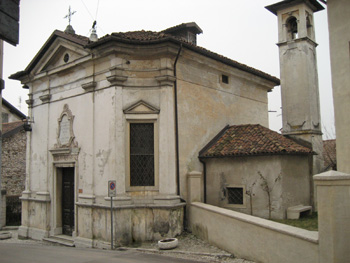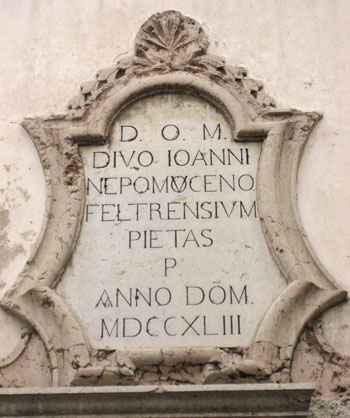| Card n. | Description | Locality | Linked sites |
| 73 | Church of San Giovanni Nepomuceno | Feltre | 15 - 14 |
| file .pdf | Architecture Art History (ASA) | Google maps |
 |
 |
- Description
- How to get there
- Interesting facts
- Bibliography
Requested by the people of Feltre to protect them from the frequent floods caused by the Colmeda torrent, the church was built in 1743 by a Venetian architect over the ruins of one of the towers in the city walls. After being destroyed during the 1917-18 invasion, it opened its doors once more on 22 September 1943 in permanent remembrance of war victims, following restoration work carried out with the contribution of Senator Achille Gaggia and the help of the troops of the Alpini regiment, who were entrusted with maintaining and taking care of the church. The interior is bright but spartan, with attractive pilasters in the corners and a denticulate cornice. There is an elegant ceiling lamp in Murano glass, a few kneeling benches, the Stations of the Cross and a single stone altar; a number of stones are set into the wall in remembrance of the Alpini soldiers killed in wartime. The torrent that runs just below the walls around Feltre is the Uniera, which then joins the better-known Colmeda, which begins on the slopes of the Vette Feltrine, and was depicted in a painting by Jacopo Bassano in 1576. The first documented major flood of the Colmeda was in 1564. Just before Pedavena, the Colmeda picks up the waters of the Porcilla torrent and the Uniera stream at Feltre, just after which it joins the Stizzon to form the Sonna torrent.
It should also be remembered that water is a fundamental element in the Christian sacrament of baptism, and particularly interesting is the Baptistery of Feltre (14 HAA), situated just outside the city walls and built over the remains of the early Christian apse and Roman structures heated using the ipocaustum underfloor system. The building was originally consecrated to San Lorenzo, and later, in the 16th century, to the Beata Vergine del Rosario. It was given the name of Baptistery following the abandonment of the circular structure that once stood in front of the Cathedral, around the second half of the 14th century.
The church is in the Old Town of Feltre, just a few metres from the Bishopric, within which is the Diocesan Museum. It can be reached by passing through the sixteenth-century Porta Imperiale gate or going up the “Daniello Tomitano” steps from the Tezze neighbourhood.
ACCESSIBLE: outside only
MUNICIPALITY: Feltre
PLACE: Cathedral area – archaeological museum
GEOGRAPHICAL COORDINATES: X 1725050 - Y 5100181
PROVINCE: Belluno
FILE COMPILED BY: Lonzi
San Giovanni Nepomuceno was born in Prague around 1340-50 and was canonised in 1729. Thrown from Charles Bridge in Prague and drowned on the orders of King Wenceslaus IV in 1393 because he refused to violate the seal of the confession of Queen Sophia, the faithful pray to this saint for protection from the waters. San Giovanni Nepomuceno is generally found near bridges, fords and lakes, and is normally depicted dressed as a priest, with an ermine cape and a crucifix in his hand, and his fingers to his lips indicating silence, as well as a five-star halo around his head. This church in Feltre is the only one in the province of Belluno dedicated to San Giovanni Nepumuceno; other artistic objects can be found in the Church of S. Biagio in Alleghe, in the Cathedral of Belluno, in Salce, Falcade, Fornesighe, Zoldo Alto, Cusighe, San Gottardo, in the Difesa Church in Cortina and on the fountain in front of the House of Titian (see file 13). The saint is believed to protect river folk and raftsmen, together with San Nicolò, Santa Barbara, San Cristoforo and Santa Filomena.
T. Conte, P. Rossi, Feltre. Guida, Feltre, 2003
A. Pellin, Storia di Feltre, Feltre, 2001
Diocese of Feltre, Le nostre chiese. Catalogo illustrato, Feltre, 1964

